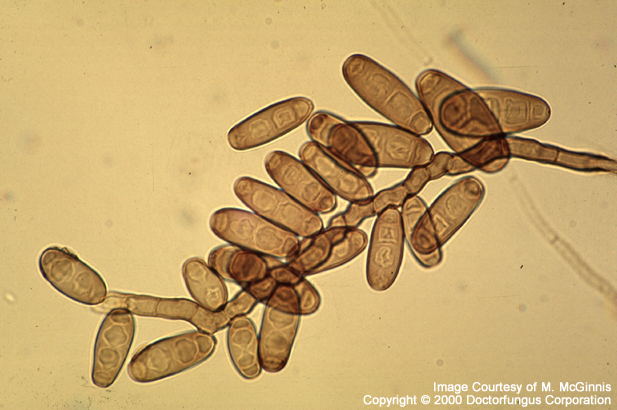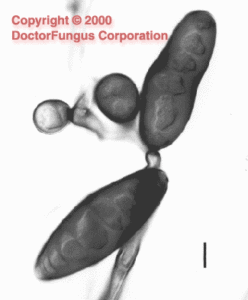(described by van Tieghem in 1876) Berkhout, 1923 nom. cons.
Taxonomic Classification
Kingdom: Fungi
Phylum: Ascomycota
Class: Euascomycetes
Order: Pleosporales
Family: Pleosporaceae
Genus: Bipolaris
Description and Natural Habitats
Bipolaris is a dematiaceous, filamentous fungus. It is cosmopolitan in nature and is isolated from plant debris and soil. The pathogenic species have known teleomorphic states in the genus Cochliobolus and produce ascospores.
Species
The genus Bipolaris contains several species. Among these, three well-known pathogenic species are Bipolaris spicifera, Bipolaris australiensis, and Bipolaris hawaiiensis.
Synonyms
See the summary of synonyms and teleomorph-anamorph relations for the Bipolaris spp.
Pathogenicity and Clinical Significance
Bipolaris is one of the causative agents of phaeohyphomycosis. The clinical spectrum is diverse, including allergic and chronic invasive sinusitis, keratitis, endophthalmitis, endocarditis, endarteritis, osteomyelitis, meningoencephalitis, peritonitis, otitis media (in agricultural field workers),and fungemia as well as cutaneous and pulmonary infections and allergic bronchopulmonary disease. Bipolaris can infect both immunocompetent and immunocompromised host [1461, 1475, 1487, 1495, 1586, 1680, 1739, 1799, 1847, 1873, 1936, 1956, 2042, 2177, 2182, 2297, 2345, 2359].
As well as being isolated as saprophytes on plants, Bipolaris may be pathogenic to certain plant species, particularly to Graminiae and also to animals, such as the dog [2387]. It may cause nasal mycotic granuloma in the cattle [1753]. Bipolaris may also be isolated as a laboratory contaminant.
Macroscopic Features
Bipolaris colonies grow rapidly, reaching a diameter of 3 to 9 cm following incubation at 25°C for 7 days on potato dextrose agar. The colony becomes mature within 5 days. The texture is velvety to woolly. The surface of the colony is initially white to grayish brown and becomes olive green to black with a raised grayish periphery as it matures. The reverse is also darkly pigmented and olive to black in color [462, 1295, 2144].
Microscopic Features
The hyphae are septate and brown. Conidiophores (4.5-6 µm wide) are brown, simple or branched, geniculate and sympodial, bending at the points where each conidium arises from. This property leads to the zigzag appearance of the conidiophore. The conidia, which are also called poroconidia, are 3- to 6-celled, fusoid to cylindrical in shape, light to dark brown in color and have sympodial geniculate growth pattern. The poroconidium (30-35 µm x 11-13.5 µm) is distoseptate and has a scarcely protuberant, darkly pigmented hilum. This basal scar indicates the point of attachment to the conidiophore. From the terminal cell of the conidium, germ tubes may develop and elongate in the direction of longitudinal axis of the conidium [462, 1295, 1495, 1548, 2144].
Teleomorph production of Bipolaris is heterothallic. The perithecium is black in color, and round to ellipsoidal in shape. The ascospores are flagelliform or filiform, hyaline in nature and are found in clavate-shaped or cylindrical asci. Each ascus contains eight ascospores.
Histopathologic Features
Phaeoid hyphae (diameter: 2-6 µm) with frequent septations are observed. The hyphae may be branched or constricted at points of septations [462].
Compare to
Curvularia, Dissitimurus, Drechslera, Embellisia, Exserohilum, Helminthosporium
Key Features for Differentiation
| STRUCTURE | DIFFERENTIATION |
|---|---|
| Fusoid to cylindrical conidia that are evenly pigmented | Bipolaris (+) Curvularia* (-) |
| Distoseptate conidia | Bipolaris (+) Curvularia** (-) |
| Profuse conidiation | Bipolaris (+) Drechslera (-) |
| Slight protrusion at conidial hilum | Bipolaris (+) Drechslera (-) |
| Germ tube perpendicular to conidial axis | Bipolaris (-) Drechslera (+) |
| Germ tube originating from any cell of conidium (not only from terminal cell) | Bipolaris (-) Drechslera (+) |
| >5 septa in conidia | Bipolaris (-) Exserohilum (+) |
| Strong protrusion at conidial hilum | Bipolaris (-) Exserohilum (+) |
| Geniculate sympodial conidiophores | Bipolaris (+) Helminthosporium*** (-) |
| Conidia which are larger at the base (obclavate in shape) | Bipolaris (-) Helminthosporium (+) |
*Central conidial cell is darker and larger
**Conidia are septate from one side wall to other (not distoseptate)
***Have erect conidiophores
Laboratory Precautions
No special precautions other than general laboratory precautions are required.
Susceptibility
In vitro susceptibility testing procedures have not been standardized for dematiaceous fungi yet. Very limited data are available on susceptibility of Bipolaris. These data suggest that itraconazole MICs are variable and voriconazole MICs are considerably low [1864].
Amphotericin B and ketoconazole are used in treatment of Bipolaris infections. Surgical debridement may be indicated in some cases, such as sinusitis [1936].



